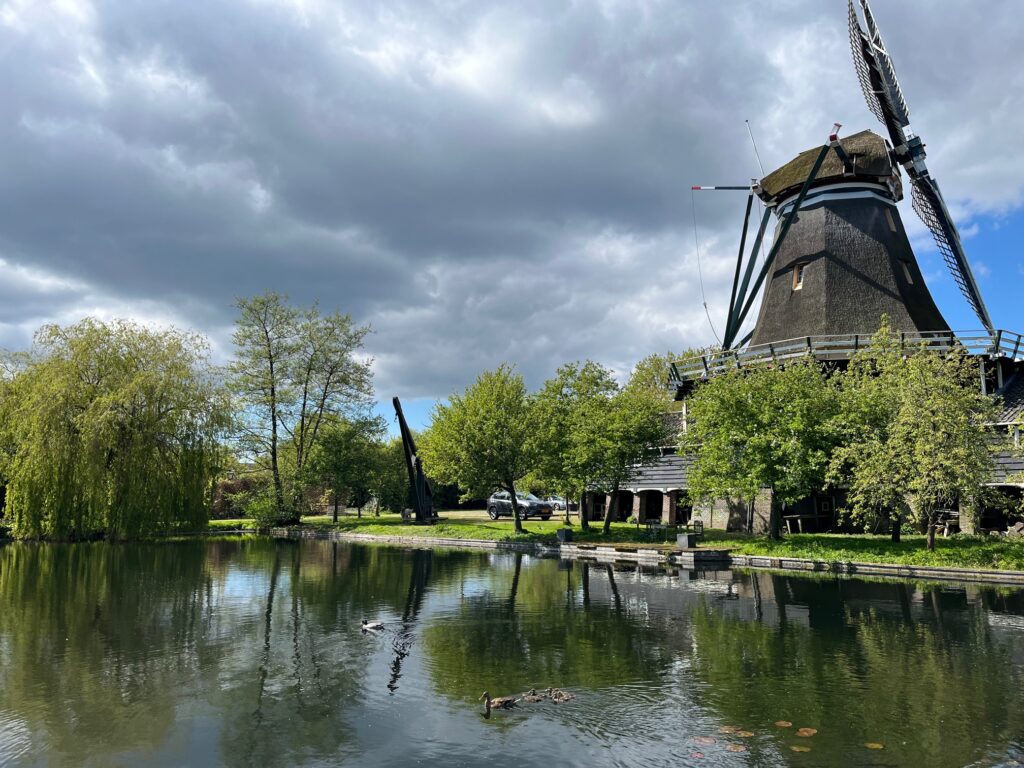We Adventuring Three

The Natalie, Mike & Jacob Adventure
After a tough and successful battle with cancer (thank you Johns Hopkins!) we decided it was time to take a much-needed break to heal and focus on our family. With no fixed address, we’re on a family adventure across Europe and beyond. We’re happy to be able to share our experiences with you, our dear friends and family!
Our goal is to update this blog every month for the rest of 2024 (more or less) for each big leg of our adventure, so come back and see what we’re up to! To see older posts, simply scroll down.
POST #6 June 2024
Days In Bergen

In June, we relocated from France to Bergen, Norway. Bergen is the second largest city in Norway – clean, visually stunning, and rather expensive. The city is surrounded by mountains, causing Bergen to be called the “city of seven mountains”. From our beautiful neighborhood of Nordnes, we explored the harbor, museums, the university, parks, and stave churches. We ate hot dogs (a Norwegian obsession), spent lots of time at the amazing playgrounds, and figured out the very thorough recycling requirements.
Norway’s oil wealth makes it one if the richest countries on earth, and it showed. The extreme environmental consciousness and attitude there was a little hard to take at times given that its prosperity is directly linked to fossil fuels.
Bergen is the rainiest city in Europe, so we put our raincoats on like the locals and did the thing. Fortunately, we did get several stretches of sunny weather along the way.
Nordnes – Our Beautiful Neighborhood

Nordnes is a ½ mile-long peninsula that stretches into Bergen Harbor. It was a beautiful base to explore both Bergen and all of Norway. The primary and pastel-colored houses, cobblestone brick streets, nice harbor views, amazing playgrounds and the lovely Nordnesparken made a scenic backdrop for our family – and people wandering through from the daily cruise ship arrivals. The hills helped us made the most of the 10,000 daily steps we tried to get!



Bergen – Harbor and Port

Our almost daily walk down to Bergen Harbor was always interesting. The amazing Bryggen historic harbor, a UNESCO World Cultural Heritage site and the most famous image of Bergen, served as both a backdrop and place to explore. We found some of the Norwegian Trolls there, the nearby castle, and the summer carnival with rides and a Ferris wheel.



The Harbor is home to the famous fish market, complete with seafood, cruise ship tour groups, and giant King Crabs in tanks. The crabs seemed like THE big attraction for the 10 and under crowd. We sampled seafood when not at the McDonalds (we had a 4-year-old, after all…) – the food quality there is far superior to a US McDonalds and Natalie could eat gluten-free!

From the harbor, we took a packed cable car up the mountain for amazing harbor and city views. It was apparent from the global cross section of tourists with us that Bergen is no secret! We played an amazing playground and took an ambitious hike back down – Jacob’s enthusiasm for running was tested by switchback trails with no guardrails and huge drop-offs.


On the other sides(s)of Nordnes are two ports that accommodated the 2-3 daily cruise ship arrivals. Being there during the peak season, on many days five thousand people or more would wander ashore, often in silly looking cruise-line company provided rain ponchos, to take in the beauty and seafood. Or one of the many TGI Fridays that seem to pop up in Scandinavia (go figure?).
Explorations Around Town

A month-long stay allowed us to explore many corners of the town. The beautiful University of Bergen grounds and museums and surrounding Syndes neighborhood, including the Johanneskirken, were inspiring destinations.
In the center of town, the city park (Byparken) and its climbable modern art kept Jacob busy. We all strolled serval times along the Festplassen and the big octagonal lake (Grinegutten). The Ole Bull Fountain also was another favorite Jacob climb. It commemorates Ole Bornemann Bull, a famous violinist and composer from Bergen. Occasionally he’d annoy some cruise ship tourists that wanted a picture of it, but too bad for them – there were always kids (and adults) climbing on it.




The tram made it easy to get to places further afield. We took field trips to places like the Fantoft Stavkirke (Fantoft Stave Church), an early medieval wooden church in the striking stave style.
Food
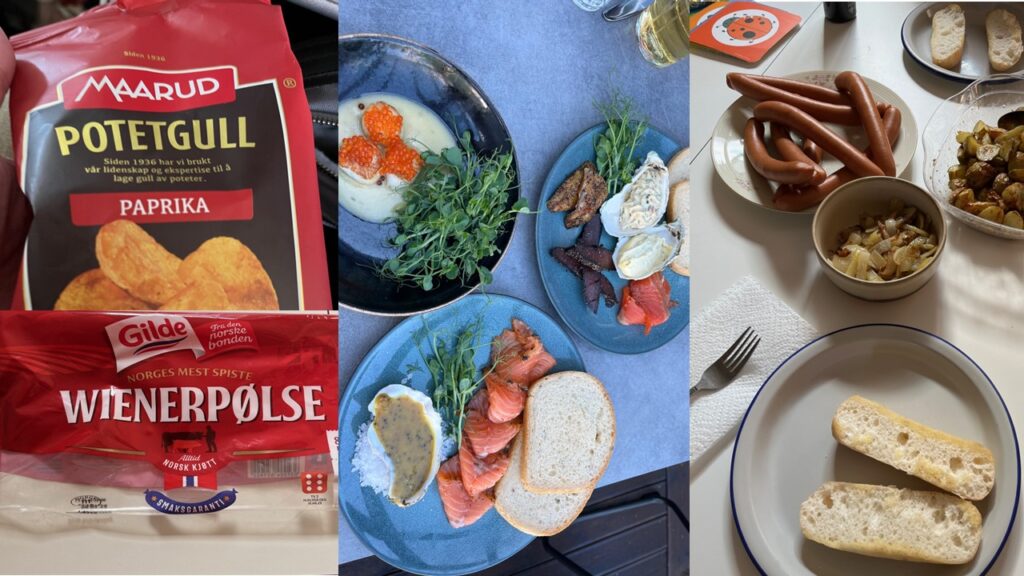
There are lots of grocery stores in Bergen, and the two Bunnpris within walking distance became almost daily destinations. Once we decided use Google Translate – and not just guess the contents of Norwegian labeled food – Mike no longer came home with buttermilk instead of whole milk. Narvesen convenience stores sold wrapped ice creams that were the best ice cream we ever tasted! And we discovered Norway’s delicious Maaurd brand paprika potato chips.
We tried traditional Norwegian seafood once – it was interesting. I don’t think Natalie wants anymore salmon (it’s abundant here but tastes a little different) and Mike had his “once is probably enough” experience eating whale.
We also cooked up the Norwegian national obsession – hot dogs. We didn’t see that one coming. Norway is very serious about its hot dogs – the Norwegian wienerpølse. American fast food came to Norway in the 1950s and became a part of the culinary culture. Today, six out of ten Norwegians eat a hot dog at least once a month.
POST #5 May 2024
Paris and the Eiffel Tower

Many months before the start of our adventure, Jacob requested that we go see the Eiffel Tower. So, during our first week in Dijon, we took a quick trip on the train from Dijon to Paris. We booked a “YOLO” apartment right across the street from the tower. The view out our windows was amazing – we couldn’t stop looking!

Trip to the Top!

Given the proximity to the Olympic games in Paris in July, we literally booked just about the last available tickets to ride to the top of the tower. Many thanks to our friend Stefanie for suggesting we jump on it, as we were planning to wait until early July.
Mom conquered her fear of heights (sort of) and we all went up to the very top! Jacob led the way on the elevators, standing right next to the windows to watch our ascent, and up and then down the stairs. We elected to walk all the way down from the 2nd level (it’s higher than it sounds!), which was quite an experience.
The Light Show

Every evening, the Eiffel Tower adorns itself in gold and sparkles with lights the first five minutes of every hour, while the beacon at the top shines across Paris. We watched right from our apartment living room window! Jacob was in awe (and so were Mom and Dad). It was a great core memory for our family.
The Olympics and VE Day

Preparations for the July 2024 Olympics were everywhere. We saw the temporary stadiums where the main ceremonies and other events will take place. There were lots of changes and road closures already in evidence (and a fair amount of machine-gun toting police and military personnel).
We also happened to be in Paris on VE (Victory in Europe) Day or ‘Victoire 1945’, a national holiday, usually celebrated with church services, ceremonies, and parades. The President lays a wreath at the tomb of the Unknown Soldier at the foot of the Arc de Triomphe at the top of the Champs Elysées. French flags were everywhere, and we saw a very impressive procession with hundreds of uniformed military on horseback riding to the wreath laying ceremony.
POST #4 – May 2024
France – Wine & Champagne Adventures

We explored three different parts of France and learned about Champagne (bubbly wine is Natalie’s favorite), Burgundy and Cremant wines.
Epernay and the Avenue De Champagne

On our way to Dijon from Leiden, we stopped over in Epernay – the “capital” of the Champagne region and industry. It did not disappoint. We had perfect weather as we explored the famous Avenue De Champagne, a kilometer-long street with all the main champagne houses and their tasting patios.
The Moet people and facility were too snooty for us, but we enjoyed excellent tastings at several others. Champagne “at the source” was amazing and delicious – our favorite was Boizel, where Jacob got to sample expensive (8 euros) but excellent apple juice.
Burgundy Wine Tastings and Tour

Dijon is the heart of Burgundy, so of course we had to do wine tastings and a vineyard tour. Our excellent guide Emiline educated us on the region and took us out on an inspiring tour and tasting around the Gevrey-Chambertin Appellation Village of the Côte de Nuits region (Côte-d’Or). This appellation includes 26 Premiers Crus Climats and produces 9 appellations Grands Crus. You’ll have to look that all up to understand it – we did too 😊The Gevrey-Chambertin vineyard is one of the most prestigious in Burgundy, and indeed in France and the world, with 310 hectares of Pinot Noir grapes vinified into red wine.
Everyone was very accommodating of a family with an active 4-year-old, and Jacob really enjoyed it. He even found a real snail in one of the vineyards! They seemed to be everywhere, so we see how inevitably they’ve become part of French cuisine.
Our adventures happened to correspond with parts of this year’s Tour de France, which is the equivalent of the Super Bowl for the French. The Tour stops twice right where we toured. MÂCON to DIJON is stage 6 and NUITS-SAINT-GEORGES to GEVREY-CHAMBERTIN is stage 7 this year.

We also explored the Crémant wine region centered on the town of Irancy. The overlooking view was a great stop for a picnic, and a run the through the vines!
POST #3 – May 2024
France – Exploring the Castles and Towns of Burgundy

Dijon allowed access to incredible side trips. The countryside in this region of France is beautiful. The lighting is somehow different, and we often felt like we were in a Cezanne or Monet painting. Our friends Luke and Stefanie are living in France and joined us on two occasions, which was lovely.
Castles and Chateaus

There are no shortages of castles and chateaus in France. We were able to visit four of them, each with its own vibe. The Château de Commarin was in the lovey little town of Commarin – a real classic “castle”. It is one of the rare castles in France not to have never been sold or looted during the French revolution. Originally a Fortified House, Commarin was transformed into a fortified castle during the omnipotence of the Dukes of Burgundy. It has belonged to the same family for over 900 years and is still inhabited.

The Chateau de Sully is still a private residence, with a lot of history. While impressive, without state funding, it seemed a little tired on the inside – there is just so much to upkeep on these things. We unknowingly met the Duchess of the castle at the entrance who struck up a conversation and told us she’d lived in Georgetown (DC) for a while. Sully was built on what is reputedly the site of the local Gauls last stand against the Roman army, around 54 BC.

Chateau Malain dates to the year 1000. We hiked ten minutes up a mountain to get inside, only to be told it was cash only for a ticket. Jacob found a trail that led to the outer walls -and we were rewarded with amazing views of the countryside! Malain means “evil” in France, and apparently the castle is popular for annual pagan/satanic festivals and such.

Chateau de Bussy-Rabutin was built from the 1200s onward. It’s fancy grounds and interior were impressive. Bussy-Rabutin was a noble who fell out of favor of Louis XIV for writing a scandalous book about the court and was ordered by to retire to his estates in the 1600s.During his exile, he amassed a collection of portraits, which remains in the château. There were some cool rooms in this one.
2000 Years of Towns

Meeting up with our friends Luke and Stefanie was the impetus to explore some great places!
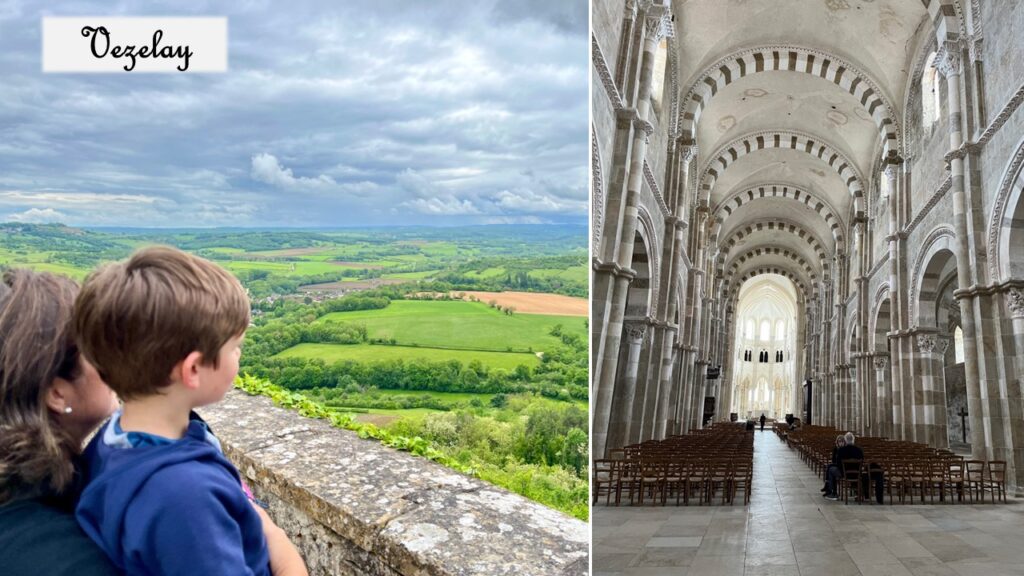
Vezelay is a defensible hill town famous for Vézelay Abbey. The town and its 11th-century Romanesque Basilica of St Magdalene are designated UNESCO World Heritage Sites. From the 1st century, the Romans set up the winegrowing on the hill. Natalie did some expert driving for us there through very narrow medieval streets.

Avallon was a “typical” French town with a great feeling to it. Its chief building, the formerly collegiate church of Saint-Lazare, dates from the twelfth century, and is charmingly deteriorated. The town is raising funds to renovate.
Autun was founded during the reign of the first Roman emperor, Augustus. It has two Roman gates and other ruins dating to the time of its founding. The ancient theatre was one of the largest in the western part of the empire with a 17,000-seat capacity. We hung out in the seats and sang from the stage to experience the still impressive acoustics. And we saw a snake!
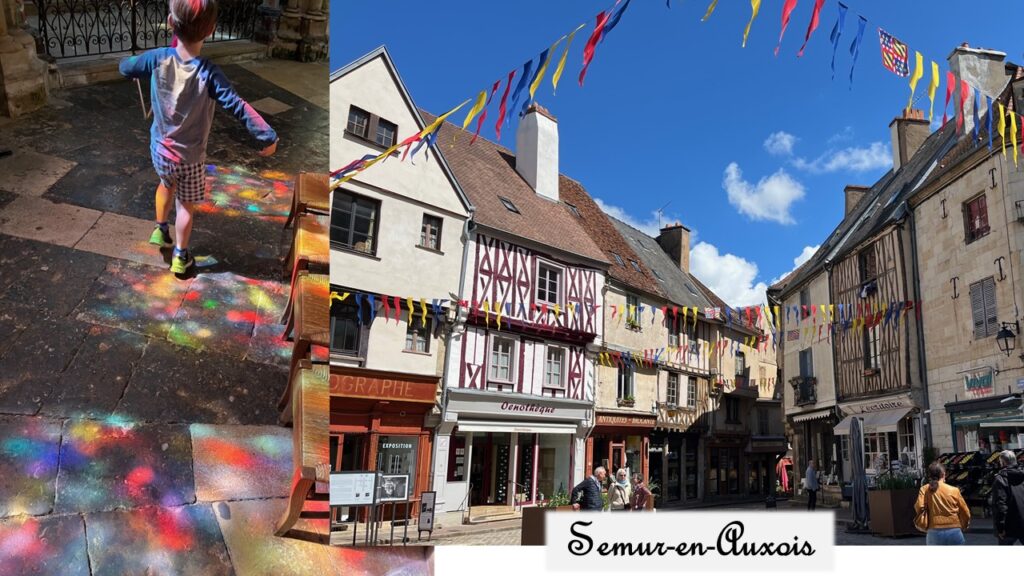
Semur-en-Auxois is a beautiful postcard of a medieval town. By chance, we had some of the best ice cream and homemade candy we’ve ever tasted. It also was the start of stage 8 of this year’s Tour de France (SEMUR-EN-AUXOIS to COLOMBEY-LES-DEUX-ÉGLISES).
POST #2 – May 2024
France – Days in Dijon
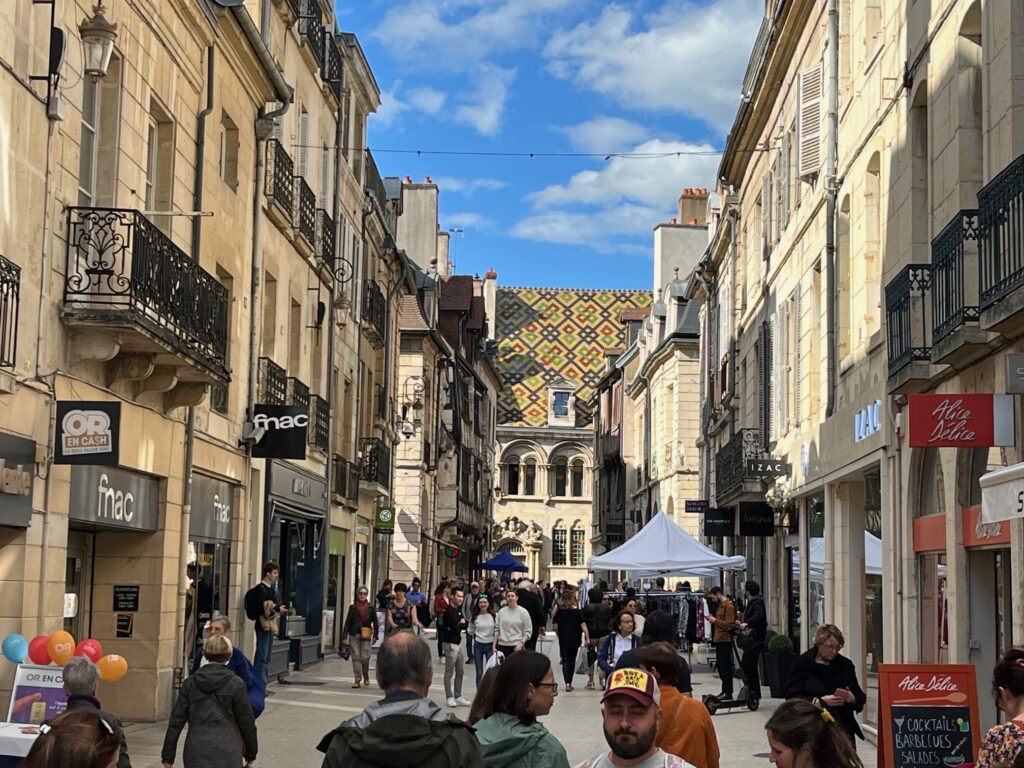
In May, we relocated from the Netherlands to the heart of medieval Dijon, France. Dijon is the center of Burgundy and its wine region, and foodie capital of France. And yes, the mustard capital. We explored the architecture, churches, museums, parks, the legacy of the Dukes of Burgundy, and rode trams and carousels.
It rained a lot in our month there. Apparently, it had been raining in France for 6 months straight. The locals seemed a little grouchy about it. Having packed for our June stay in Bergen, Norway – a very rainy city – we were prepared to stay dry.
Hanging Out, Eating, and Getting Around in Dijon


Place de la Liberation and the Palace of the Dukes of Burgundy are the heart of Dijon and served as our go-to hang out places. Jacob played in the fountains, ran around the huge plaza, and Mom and Dad enjoyed time to actually talk to each other one-on-one. After WWII, the locals publicly hanged the guy who led the Nazi occupation of Dijon in this expansive plaza to accommodate the onlookers, a sobering reminder of the not-so-recent past. We climbed the 316 steps to the top of Tour Philippe le Bon for a magnificent view. The big arch – Porte Guillaume – was a distinctive landmark that helped us (well, Mike anyway) navigate the city core.


Place François-Rude (named for the sculptor) was also a place we spent quality time. Jacob took many rides on the carousel, spinning in a hot-air balloon as fast as possible and flying in the Little Prince’s plane while his parents enjoyed a Sorre cider and galettes.

One of the best things about our time there were our days in the Jardin de l’Arquebuse, a lovely large park with extensive gardens. We really unwound and enjoyed life surrounded by beautiful flowers, fountains, and the infrequent sunny days.

We tried to eat well, but Dijon was not as gluten-free as we’d thought – and we also had a 4-year-old picky eater in tow. We did enjoy galettes, Dijon mustard, and lots of delicious cheese and wine of course. Ironically, we had an incredible meal – maybe our best – at a restaurant in a shopping mall in the suburbs! We did also sample some of the food at the large market – the Halles Centrales. The market days in Dijon, especially Saturday, saw a big influx of people and energy into the city center.
Dijon Churches, Museums & Architecture


The medieval architecture and half-timbered houses in Dijon were incredible. The famous colorful roof tiles were in evidence on many buildings. Dijon was largely spared the destruction of past wars, so many of the old buildings dating from the 12th to the 15th centuries are undamaged. The roof tiles originated from the Dukes of Burgundy and the Flemish artists they commissioned.

Dijon has several old churches with impressive interiors and stained glass. Jacob loved one in particular – Saint Philibert’s Church – which he named “the church with the spikes”. This church is in disrepair, and currently no one can go inside. Jacob was quite disappointed and still talks about it. We made several visits to others, including Cathédrale Saint-Bénigne de Dijon and Église Saint-Michel.

We walked the famous Owl Trail and touched the stone owl – La Chouette de Dijon – at the 13th century Église Notre-Dame de Dijon cathedral every day for good luck. Notre Dame has dozens of impressive gargoyles and the stone owl carved into a corner of the exterior, said to grant wishes when stroked with your left hand.

Musée Rude – The Rude Museum is housed in a church dating back to the 5th century and is dedicated to the French sculptor François Rude (1784–1855) and has other stuff from the 11th century onward. We enjoyed his immense sculpture, the famous La Marseillaise (The Departure of the Volunteers of 1792). It honors France’s first citizen army, formed in response to a threatened invasion by a Prussian/Austrian coalition. Perhaps we were a bit silly considering it seems so serious 😊

The Musée des Beaux-Arts de Dijon is a museum of fine arts opened in 1787. Next to the Louvre, it is France’s premier art museum. An impressive array of items filled a morning for us, including the tombs of Burgundian dukes, an ancient Egyptian sarcophagus and works by Cezanne and Monet. Jacob kept the museum staff (and Mom and Dad) on their toes, as the normal 4-year-old urge to touch and explore doesn’t always mix well with priceless works of art.

The Well of Moses (French: Puits de Moïse) is a monumental sculpture executed by the Durch artist Sluter 1395–1403 for the Carthusian monastery of Chartreuse de Champmol. It’s on the outskirts of Dijon, and we ambitiously walked to it. Little did we know that the well and the old monastery are surrounded by a working psychiatric hospital. We got some odd looks on our way through! We found the Well of Jacob on the grounds (Puits de Jacob), which was very exciting of course.
